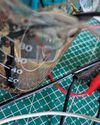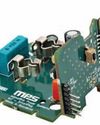Is India's FAB VISION On Track Despite RECENT SETBACKS?
June 2025
|Electronics For You
Paused, not derailed—experts see the Adani and Zoho exits as distinct but strategic, not setbacks. Rather than failure, they signal a pivot: India’s chip drive now hinges on design depth and delivering existing models.

On April 30, 2025, reports emerged that the Adani Group had paused discussions with Israel’s Tower Semiconductor regarding a much-anticipated $10 billion chip fabrication model in India. A day later, software major Zoho announced the suspension of its $700 million plan to enter chip manufacturing.
The Economic Times framed these exits as a “setback to Prime Minister Narendra Modi, who has for several years tried to lure companies in his pursuit to make India a global chip manufacturing hub.”
Yet the reasons diverged. Zoho founder Sridhar Vembu explained that, despite an extensive search, the company could not secure a suitable technology partner to navigate the complexities of chipmaking. Adani, on the other hand, cited uncertainty around domestic demand and doubts over the model’s viability.
The shelving of two high-profile, capital-intensive ventures raises critical questions. What do these exits mean for India’s semiconductor roadmap—particularly as the domestic market is projected to reach $64 billion by 2026, and Union Electronics and IT Minister Ashwini Vaishnaw maintains that ‘Made-in-India’ chips will debut by year-end? Do these developments point to structural gaps in India’s readiness for chip manufacturing? Are policy frameworks overly optimistic—or are such shifts part of a natural evolution shaped by global headwinds?
A timeline
On September 6, 2024, Adani Group partnered with Israel’s Tower Semiconductor to establish a $10 billion semiconductor fabrication plant in Taloja, near Mumbai, maharashtra. Approved by the Maharashtra state government, the project was to be developed in two phases; the first with a production capacity of 40,000 semiconductor wafers per month, followed by expansion to 80,000 wafers per month in the second phase.
هذه القصة من طبعة June 2025 من Electronics For You.
اشترك في Magzter GOLD للوصول إلى آلاف القصص المتميزة المنسقة، وأكثر من 9000 مجلة وصحيفة.
هل أنت مشترك بالفعل؟ تسجيل الدخول
المزيد من القصص من Electronics For You

Electronics For You
Tech Majors Are Racing TOWARDS NET-ZERO - What About You?
Apple, Microsoft, Amazon, Google, Infosys, Wipro—global and Indian firms are heading closer to achieving net-zero emissions, a mandate to combat climate change. Here is what you need to know to start your journey...
12 mins
December 2025

Electronics For You
Miniature IoT WATER TDS And LEVEL MONITOR Cum CONTROLLER
For setups that rely on stored water, clear awareness of tank level and water quality is essential.
3 mins
December 2025

Electronics For You
The Impact Of GENERATIVE AI On The Future Of AUTOMOTIVE AND EVs
Autonomous vehicles, connected ecosystems, and smart factories are only the beginning. Generative Al is pushing the auto industry beyond predictions into a bold era of creativity-from EV design to real-time diagnostics and showroom automation. Here is how GenAl is reshaping innovation across the automotive value chain.
8 mins
December 2025

Electronics For You
How AI Tools Are Making SOFTWARE DEVELOPMENT BETTER
AI is reshaping how we code, debug, and collaborate. From Copilot to automation, it is changing software development in ways worth exploring.
3 mins
December 2025
Electronics For You
How AI Tools Are Making SOFTWARE DEVELOPMENT BETTER
AI is reshaping how we code, debug, and collaborate. From Copilot to automation, it is changing software development in ways worth exploring.
3 mins
December 2025

Electronics For You
5 Interesting Reference Designs FOR SMART HOMES
Smart home devices are transforming the way people interact with their appliances. They make homes more convenient, secure, and energy-efficient. From smart plugs and energy monitors to smart locks and thermostats, reference designs help design engineers create connected products that are easy to use, consume less power, and are reliable. These designs allow you to control devices remotely, track energy use, extend battery life, and automate routines. They provide practical solutions for upgrading homes and small commercial spaces without major modifications.
3 mins
December 2025

Electronics For You
Fancy USB LED VASE
This USB LED vase is a simple yet elegant device that fuses art with electronics to create a decorative lighting display. Powered directly from a standard USB port, it uses readily available components such as MOSFETs, resistors, capacitors, and LEDs to produce a striking, dynamic sequence of lights.
3 mins
December 2025

Electronics For You
"WHAT OTHERS SELL IN FOUR BOXES WE BUILT IN ONE"
Years of custom field work are shaping a product line with its own cloud, its own hardware, and a market that is now beginning to recognise its value.
8 mins
December 2025

Electronics For You
BUILD LARGE LANGUAGE MODELS
Large language models are machine learning models designed for a range of language-related tasks such as text generation and translation. Here’s how open source software can help you build your own large language model.
6 mins
December 2025

Electronics For You
Rare Earth Or Rare Ingenuity? India Remains Between The Two
With China firmly controlling rare earth exports, India confronts a critical moment in its technological trajectory.
8 mins
December 2025
Listen
Translate
Change font size

